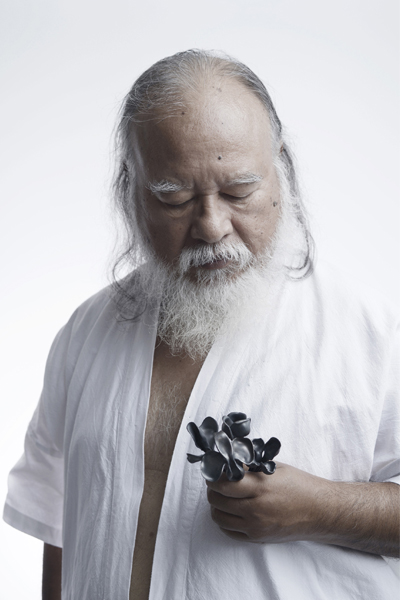March 27–April 25, 2015
Bilk Gallery, Canberra, Australia
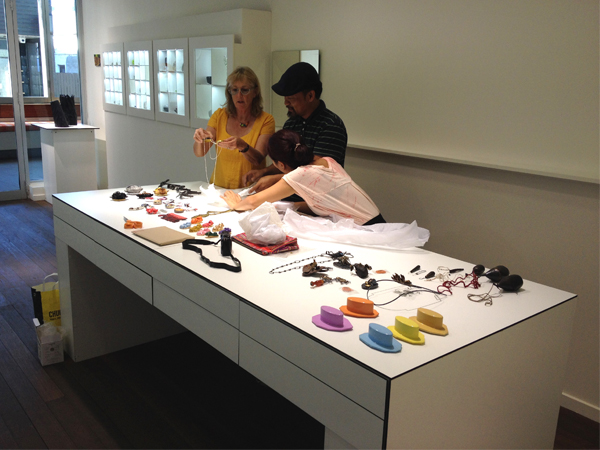
Curated by Bow Wasinondh, it is the first outing by Thai contemporary jewelers in Australia. It was enthusiastically received, and is leading to further exchanges: The show will reappear in July in Sydney, during the biennial national jewelers’ conference. The exhibition is indebted to existing relationships, especially between Bow and Sydney jeweler Melinda Young, fellow students at Sydney College of the Arts’ Jewelry and Object Design Studio between 2000 and 2002. In 2011–2012, both jewelers participated in WOHOOOH, seen in Hong Kong, Sydney, Taipei, and Bangkok, and in 2014 Melinda curated The Poetics of Place, a group exhibition by Australian jewelers for Atta Gallery. The current exhibition is, in a sense, the return bout, and the next installment will be an Australian exhibition presented by Bilk at Atta Gallery in early 2016.
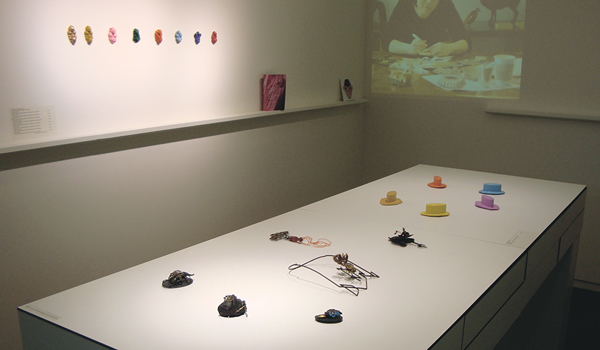 First, a snapshot: Anew Negotiation presents works by eight jewelers aged from their twenties to forties, with different origins, education, interests, and, importantly, markedly different status in their country: Some are professors, leaders in their universities; others are emerging artists. This catholicity gives a clue to the liveliness of the infant Thai contemporary jewelry scene. What is so impressive is the sheer diversity of the work. There is no house style, no hint of that unspoken consensus that can run through an artistic group like a virus, fatally limiting individual achievement.
First, a snapshot: Anew Negotiation presents works by eight jewelers aged from their twenties to forties, with different origins, education, interests, and, importantly, markedly different status in their country: Some are professors, leaders in their universities; others are emerging artists. This catholicity gives a clue to the liveliness of the infant Thai contemporary jewelry scene. What is so impressive is the sheer diversity of the work. There is no house style, no hint of that unspoken consensus that can run through an artistic group like a virus, fatally limiting individual achievement.
On the contrary, it is clear the Thais prize individuality, and welcome an unusual diversity of approaches. An example: the two senior artists, Apinya Boonprakob and Taweesak Molsawat. Apinya makes subtle ruminative works that marry found fragments from antique Chinese jewelry with perfectly articulated metal insects of her own making. The juxtaposition of the old and the new in the best brooches, such as Ornamen Tales—Warrior Beetle (2014), uses elements from several of the cultural sources that run through Thai society today, including the often-disregarded influence of china, deploying precise craftsmanship at the service of poetry. Taweesak, on the other hand, robustly interrogates contemporary Thai society and politics by affirming group struggle in one brooch, subverting military authority in others. He showed several brooches from his most recent series, such as dis/appear: Blurring Image between Cultural Hierarchy and Reality No. 11 (2014), which provocatively mixes materials of varying value—silver, plated brass, a used plastic bag, and what he described as a “used object of cultural belief.” Effectively, these are reworked military medals; my absolute favorite in the series is No. 5, a simple keyhole medal form that cuts through the artist’s coat to show his skin. In the end, Taweesak seems to be suggesting, every citizen is a hero.
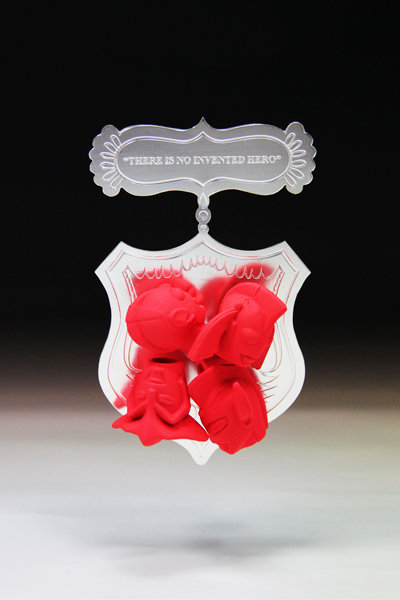
 The sense that jewelry can directly address culture, society, and politics connects these artists. For despite the variety of their work, this newly minted cohort of contemporary jewelers is sharply aware of the interrogative role jewelry can play. I was struck by the variety of contemporary social and political issues they engage, and the sophistication of the work: Atinuj (Atty) Tantivit showed a rough-hewn pendant that literally plays with a sense of the social and political schizophrenia in contemporary Thai life. In the signature red and yellow colors espoused by the major contending political parties, Siamese Twins. Live and Learn was doubled and bifurcated, using the long curvilinear shape of the country; the two parts of the work can only be joined together by the deliberate agency of the wearer. Given the two colors are so politically freighted in contemporary Thailand, wearing both simultaneously amounts to a plea for reconciliation.
The sense that jewelry can directly address culture, society, and politics connects these artists. For despite the variety of their work, this newly minted cohort of contemporary jewelers is sharply aware of the interrogative role jewelry can play. I was struck by the variety of contemporary social and political issues they engage, and the sophistication of the work: Atinuj (Atty) Tantivit showed a rough-hewn pendant that literally plays with a sense of the social and political schizophrenia in contemporary Thai life. In the signature red and yellow colors espoused by the major contending political parties, Siamese Twins. Live and Learn was doubled and bifurcated, using the long curvilinear shape of the country; the two parts of the work can only be joined together by the deliberate agency of the wearer. Given the two colors are so politically freighted in contemporary Thailand, wearing both simultaneously amounts to a plea for reconciliation.
In a personal vein, Panjapol Kulpapangkorn offered a sense of order to his distinguished mother, a retired professor afflicted by the beginnings of dementia, through a set of color-coded brooches for each day of the week. Accompanied by a short video screened on the gallery wall, showing his mother’s daily task of putting on the brooches, Panjapol’s series directly addressed the strenuous demands made on filial love and devotion, and the exemplary grace that is so often summoned by both the elderly and their families. This is wonderfully purposeful jewelry.
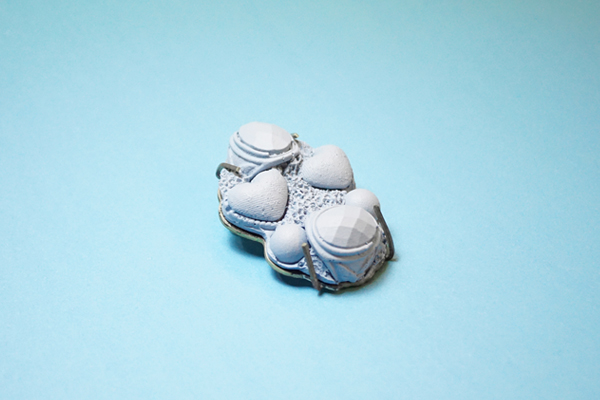
Above all, these Thai artists are committed to vigorous dialogue across disciplinary territories. Negotiation is a very Thai concept: Bow says, “I believe that we should always negotiate and renegotiate our role and our voice … what we make for and what we stand for.”[1] Perhaps this privileging of continual negotiation is not without strain or doubt, but it’s clear that openness to promiscuous relationships between many disciplines, and working through and across them, is a distinctive strength of the Thai contemporary jewelry scene. Industrial design, product manufacture, graphic design—the career paths described in the three artist talks at Bilk, on the day after the Canberra opening—are unlike the standard undergraduate to postgraduate progression in Australia, Europe, or the US. Indeed, this circumstance is clearly the source of the stylistic and methodological diversity that I referred to earlier. And the Thais are quite clear about the value of continuing to negotiate these diverse contexts.
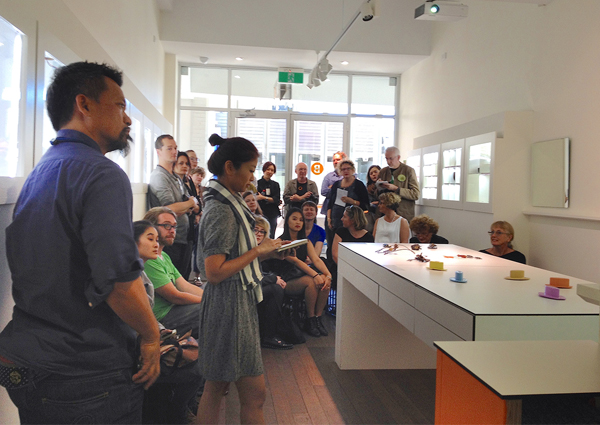 This is a singular case of hybrid cultural energy. Vinit, for instance, who originally trained as a printmaker, has, among other conceptually driven projects, made tinkling jewelry so that the blind could hear it. His inventive and independent practice—Vinit runs his own studio/retail outlet in Bangkok—is manifested here in a terrific group of Rough Gems, ebullient shapes that make candy-colored sport of formal jewelry. And why not? The Thai jewelry industry is certainly a crucial part of the setting for these contemporary artists. Thailand makes a serious claim to be the key gem-cutting and setting center in Southeast Asia, and the enormous volume of commercial and fine jewelry made there is matched by an exceptionally strong heritage in traditional jewelry, especially in silver.
This is a singular case of hybrid cultural energy. Vinit, for instance, who originally trained as a printmaker, has, among other conceptually driven projects, made tinkling jewelry so that the blind could hear it. His inventive and independent practice—Vinit runs his own studio/retail outlet in Bangkok—is manifested here in a terrific group of Rough Gems, ebullient shapes that make candy-colored sport of formal jewelry. And why not? The Thai jewelry industry is certainly a crucial part of the setting for these contemporary artists. Thailand makes a serious claim to be the key gem-cutting and setting center in Southeast Asia, and the enormous volume of commercial and fine jewelry made there is matched by an exceptionally strong heritage in traditional jewelry, especially in silver.
Perhaps because a number of Thai jewelers moved away from working with industry, including the booming commercial-jewelry industry, to find a more satisfying independent practice, they do understand how to nimbly nip between different contexts of making; and they consistently draw on a variety of disciplines. The brilliant Tithi Kutchamuch is a case in point. Originally trained in industrial design in Bangkok, she later completed a master’s in design products at London’s Royal College of Art, but left industrial design behind for making. This shift is registered in her series Travels with My Spoon: Plastic throwaway spoons are melted, then transmogrified through casting into something less transient and more valued—oxidized silver brooches in the form of flowers. Sometimes, as with Vanda, this is an orchid, or it is a rose. Some are a lotus, the key Buddhist image for the transcendence of lowliness and the achievement of enlightenment.
Exposure to international contemporary art, and training abroad, has clearly been crucial for these jewelers, a circuit-breaker then applied to their Thai circumstances. Noon Passama, the best-known artist in the exhibition, trained and now lives in the Netherlands, but she is only one of a number of jewelers who have taken their Thai education further afield, and returned transformed. In Canberra, Noon showed a group of her celebrated Portraits, which are even more engaging in the flesh than in the intelligent photographs by her Amsterdam-based collaborators severafrahm (Mirka Severa and Michael Frahm). (See AJF interview, December 29, 2013.) Tellingly, Noon was awarded AJF’s 2012 Emerging Artist Award for her collaboration with Capara, the Belgian fashion house, perhaps the most notable instance of a Thai jeweler working with industry.

Rudee Tancharoen, on the other hand, after her early training in industrial design in Thailand, spent years studying jewelry in Florence, returning to establish the only independent contemporary jewelry school in Bangkok. (See AJF interview, July 1, 2014.) Unlike others’ works, her delicate, often whimsical, works always bear the marks of her hand, here including an extraordinary stitched gold brooch from 2007, and a group of enchanting earrings whose exquisite refinement is matched by their conceptual rigor and wit: Each pair interprets one shape in two ways.
Finally, though, these works point to the jewelers’ sense of their specific cultural location, and their urgent interests as Thailand undergoes enormous political and social changes. Bow writes, “As a worker of the arts, the situation that Thailand is breathing in, is critical in rethinking the role of art in society. What is it that the artist does for the world he/she lives in, and the effect of his/her artistic expressions? … is it a living organic shifting state that is shaped by our mutual pasts and our toiling dreams?”[2] Asked in Canberra whether there is a distinctive Thai sensibility, Bow said she sees certain materials and stories as entirely Thai. Indeed. But what is so exciting is that these Thai jewelers are opening a new, and entirely convincing, negotiation with the wider world.
